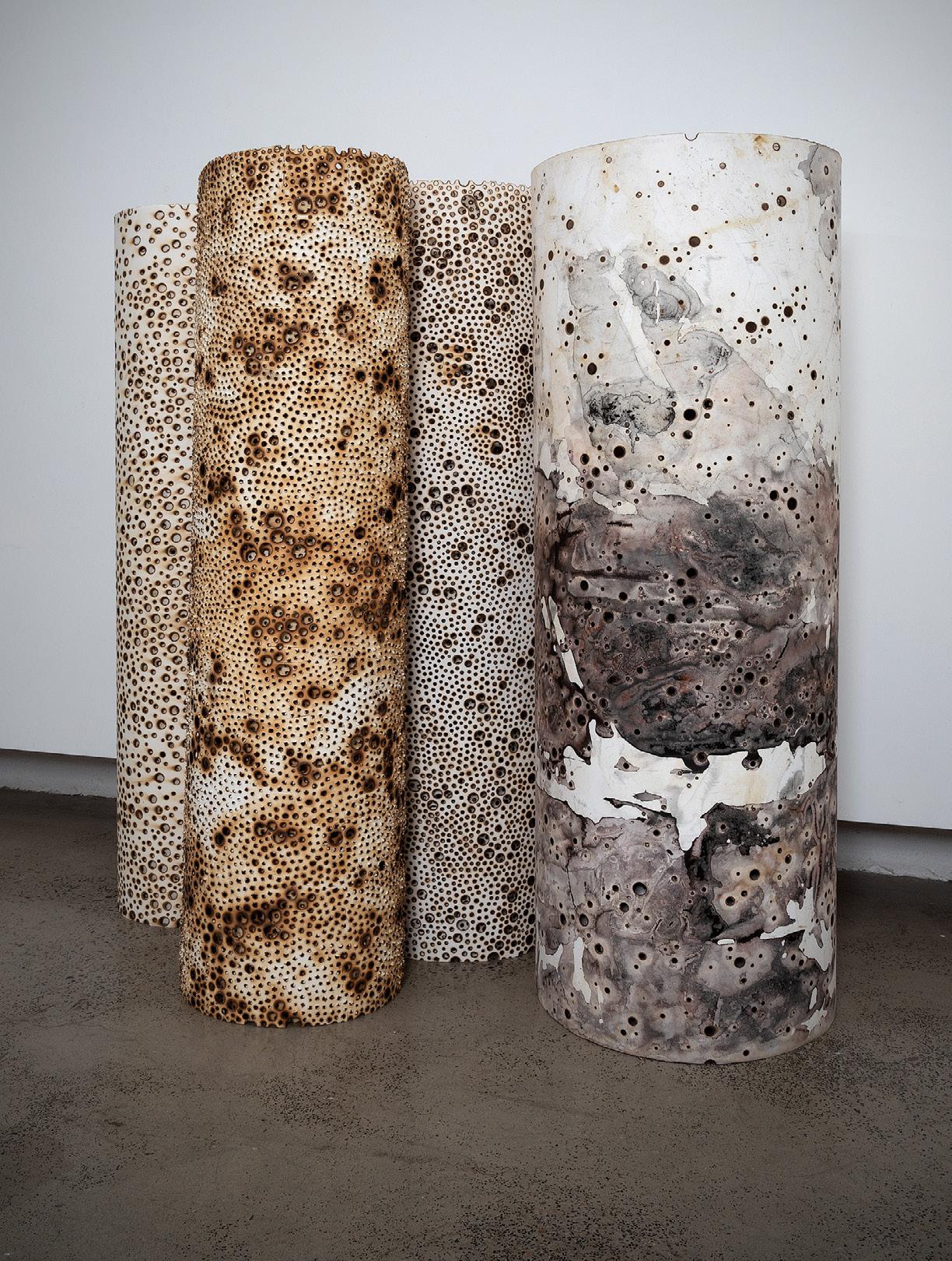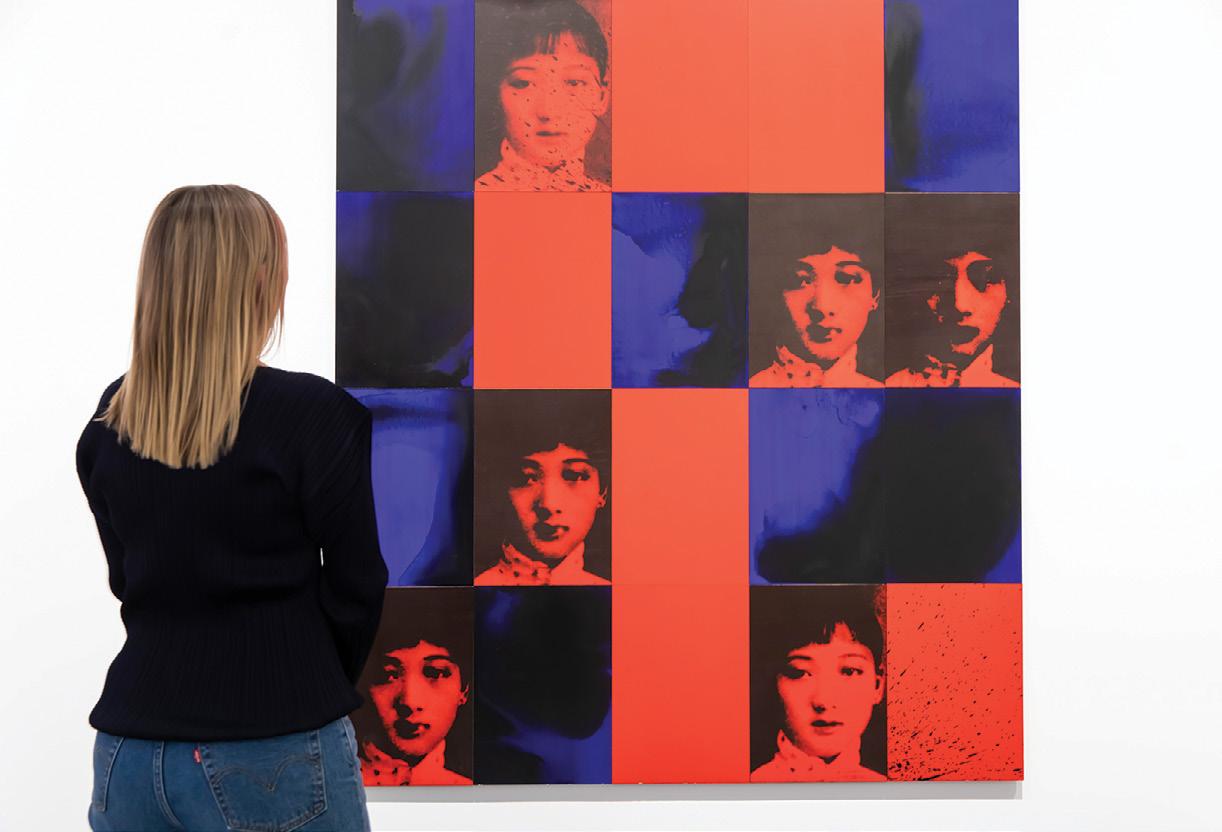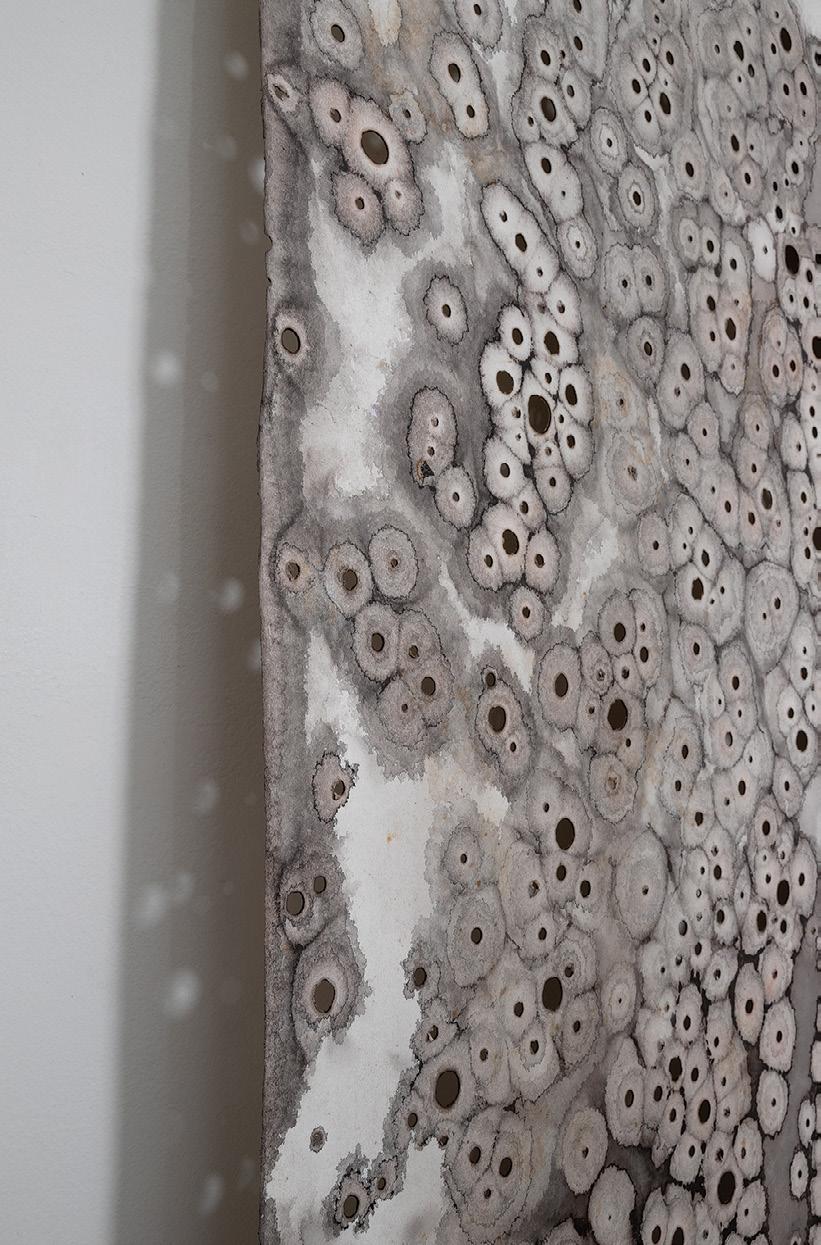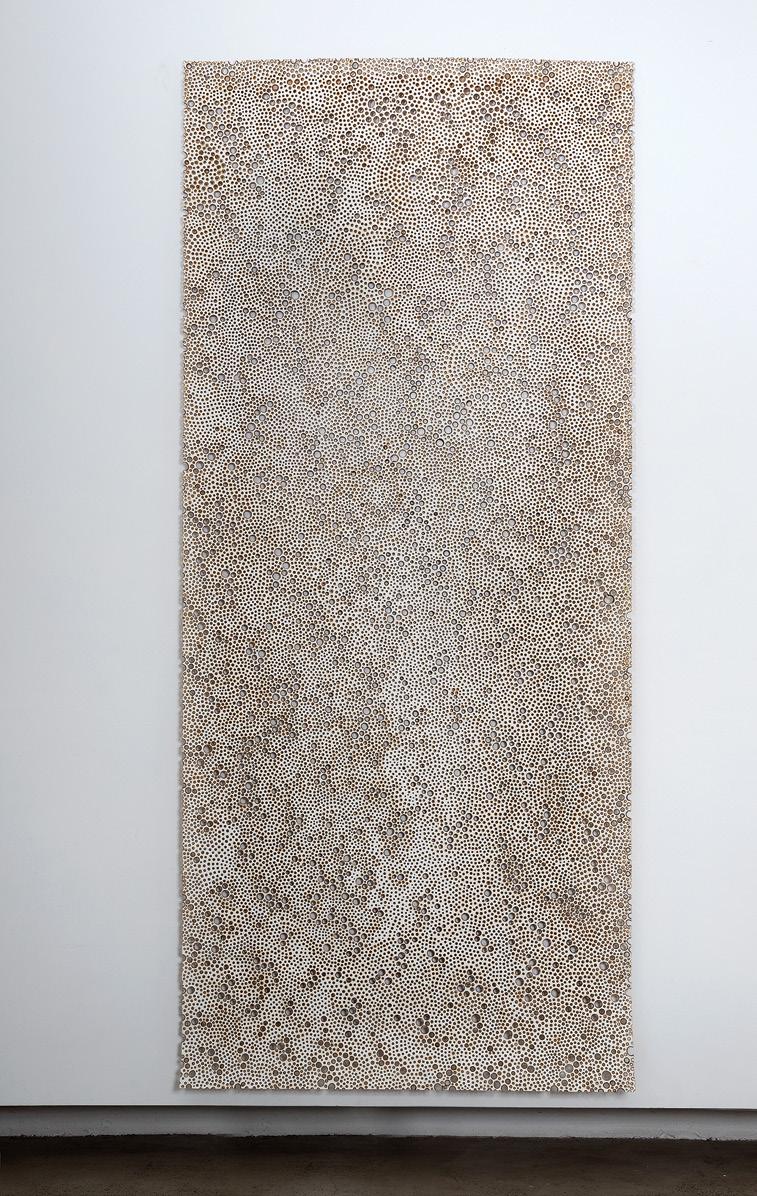
6 minute read
Lindy Lee: Love letters between the rain and the fire
By Neha Kale
For Lindy Lee, wisdom isn’t about what you think you know. It’s about the knowledge that registers in the body over the course of a life. The acclaimed Australian Chinese artist recalls talking philosophy with a group of friends as a teenager in Brisbane. Her youthful certainty, she says, has given way to the gift of hindsight.
“Lately I’ve been thinking a lot about time – as 16-yearolds at lunchtime, we would talk about the wisdom of all things,” she says. “I remember a friend of mine saying, ‘I think you can be young and wise.’ [But] I’m in my sixties and not so young.” She laughs. “Wisdom grows because you meet life as it unfolds. Time is the only vehicle through which our bodies can realise our experiences.”

Lindy Lee Moonlight Deities, 2019-2020 (detail) mixed media dimensions variable Photo credit: Anna Kučera
As 2020 draws to an end, Lee is caught up in a particularly reflective moment. It’s been two months since she installed Moon in a Dew Drop, which opened at Sydney’s Museum of Contemporary Art in October and surveys three decades of artistic output.
The exhibition holds a mirror to the many selves Lee has wrestled with in her lifetime. There’s the daughter of Chinese immigrants who tries to understand her place in Western art history by photocopying the faces of Renaissance painters, blacking out their features.
There’s the rising artist who finds a language she didn’t know she was looking for in ‘flung ink’ painting, a technique conceived by monks who lived centuries before her. Later, the Zen Buddhist whose questions about race and identity transform into deeper enquiries about our place in the cosmos and the nature of existence.
“It’s gratifying to see the breadth of work and the consistent enquiry that I somehow unconsciously carried through,” she says, referencing No Up, No Down, I Am the Ten Thousand Things, a room-sized 1995 installation for which she splashed Chinese calligraphy ink on over a thousand pieces of paper. “When I first made that work, a friend of mine who is a Zen master thought it was good but didn’t think the gesture had enough confidence.” She pauses. “But I’ve learned so much in doing it the second time, twenty years later.”
Certainty, of course, is currency in a world shaped by a global pandemic and a breakdown of historical institutions. But Lee believes that contradictions are part of our nature, a defining force. Five years ago, the artist moved to the Byron Bay hinterland, home to ancient subtropical rainforest. Last summer, bushfires raged through the region. The week before we speak, intense storms battered the local coastline. For Lee, there’s a parallel between our internal battles and this tug-of-war between the elements. It gave rise to Love letters between the rain and the fire, opening at Sullivan+Strumpf in February, her first commercial show in Sydney in four years.

Work underway for Love letters between the rain and the fire. Photo credit: Zoe Wesolowski-Fisher

Lindy Lee in her studio, 2020. Photo credit: Zoe Wesolowski-Fisher
“The strongest weather experiences we have in Australia are to do with fire and water – the lack of water in the desert is part of our psyche, the floodplains of Brisbane are part of our psyche,” she says. “We live through these cyclical seasons of bushfire which are getting worse.”
In October 2014, Lee collaborated with the artist Lyndal Jones to conceive The Garden of Fire and Water, a project that commemorated the story of Chinese immigration to Avoca, a 19th century town on the Victorian goldfields.

Lindy Lee, Moon in a Dew Drop, installation view, Museum of Contemporary Art. Photo credit: Anna Kučera

Lindy Lee, Moon in a Dew Drop, installation view, Museum of Contemporary Art. Photo credit: Anna Kučera

Lindy Lee Blossoms of the Floating World, 2020 (detail) Chinese ink, fire and rain 316 x 139.5 cm Photo credit: Aaron Anderson
“I started to burn things and play with these elements,” Lee recalls. “They are extremely volatile – we can’t live without them, but they can also kill us.”
Love letters between the rain and the fire features Dewbursts (2020) and River Confetti (2020), part of a series of new ‘weather paintings,’ an evolution of pieces on show as part of Moon in a Dew Drop. To make the works, the artist flings Chinese ink. She burns holes in the paper with a soldering iron, creating delicate constellations that recall the way droplets creep across glass or stars radiate outwards, in thrall to unearthly energy.
“[The works] are left in the rain to receive the water and the ink,” she grins.
Part of the joy, for Lee, is surrendering her role as an artist, entering into a collaboration with the elements.
“When I’m looking at River Confetti, you see the burn marks through the centre,” she says. “But there’s no way I can anticipate with any precision what the rain is going to do with the ink.”
Fire and water play a starring role in Chinese mythology. They comprise the final hexagram in I Ching, the book of divination that influenced Confucianism and Daoism and went on to shape the work of artists like John Cage and Walter De Maria. Chinese dragons, Lee explains, are also associated with this dance between the elements.
“The dragon is the master of water,” she says. “It crawls across the sky. Thunder and lightning are its voice.”
Love letters between the rain and the fire will include new drawings inspired by Chen Rong. The Daoist painter is famous for intricate handscrolls of dragons that emerge from swirling flames and thunderclouds, made in the 13th century, often as part of rainmaking rituals.
“Water has three states – solid like ice, vapour as in mist and fluid and these drawings are very much caught up in morphing and changing,” she says. “The story of the dragon and its purpose is very fitting.” Lee tells me that she’s making wooden sculptures for the first time. “One piece that I’ve been working on is electrocuted,” says Lee, who’s drawn to artists who worked with wood like Isamu Noguchi and Constantin Brâncuși. “It’s [about] transformation and alchemy, participating in the laws of nature.”

Lindy Lee, Fire in the Immanence of Unfolding, 2020 Chinese ink, fire and rain 316 x 139.5 cm Photo credit: Aaron Anderson

Lindy Lee Quiescent Mind, 2020 Chinese ink, fire and rain 316 x 139.5 cm Photo credit: Aaron Anderson
Our lives are often defined by tensions and transformations. In 1953, Lee’s mother, Lily, arrived in a Queensland shaped by the White Australia Policy after grappling with the rise of communism in mainland China. Lee’s life, she says, has always been about division, about what the German philosopher Nicholas of Cusa calls “the coincidence of opposites.” But living between these opposites, however painful, can also be the source of our wisdom, the sum of everything we are. Something as insignificant as a dewdrop, she says, contains the union of opposing elements, a love letter between fire and water in miniature.
“A dewdrop is a fragile thing that gets burned off at first light, but it has taken the power of the universe to make it,” she says. “And it has taken the entirety of time to make us.”
Lindy Lee: Love letters between the rain and the fire shows at Sullivan+Strumpf from February 11 to March 13, 2021.
References
https://repository.asu.edu/attachments/97809/content//tmp/packageAtZAnO/Chao_asu_0010E_12427.pdf https://www.christies.com/features/2017-highlight-Fujita-Museum-dragonscroll-8799-1.aspx https://www.smh.com.au/culture/art-and-design/i-found-myself-having-toaddress-this-really-repressed-part-of-me-20200917-p55wql.html https://www.wsj.com/articles/walter-de-marias-i-ching-sculpture-comes-toupstate-new-york-1461875773 https://plato.stanford.edu/entries/cusanus/









